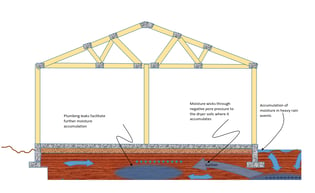Why does moisture accumulates under a slab and does not dissipate over time?
As noted in my last blog, some foundation sales personnel make some pretty outrageous claims and unfortunately most are made verbally…. where they cannot be verified, or held accountable for. In addition there is no governing ethics board to keep the conduct of these people accountable. The Key tool to hold these people accountable is to always get them in writing. Then you can do your own research to verify them. Today I would like bring to light one of such outrageous claims.
I often hear foundation contractors make the erroneous claim that if left alone the floor slab heave will dissipate and eventually take care of itself. This is not only false but in fact moisture will continue to accumulate over time. There are 4 mechanisms that facilitate continued accumulation. They are:
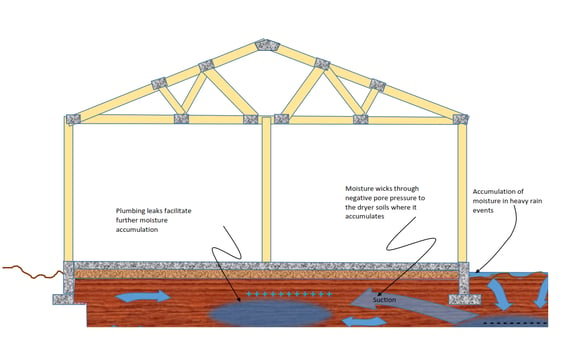 Suction - Clay soil has a negative ionic charge. Water has a positive one. As a result they are attracted to each other. Geotechnical engineers refer to this as negative pore pressure.... or suction. Although water moves very slowly through clays at about 3 inches per year, the horizontal depositional layers in the soil allow for somewhat faster movement. During heavy rain water soaks down to the soil below and because the soil in the center of the slab is much much drier, it is attracted to it. Even if the sun comes out an dries the soil where it was initially soaking wet, it will not dry it enough to reverse suction… Thus each event has accumulating effect.
Suction - Clay soil has a negative ionic charge. Water has a positive one. As a result they are attracted to each other. Geotechnical engineers refer to this as negative pore pressure.... or suction. Although water moves very slowly through clays at about 3 inches per year, the horizontal depositional layers in the soil allow for somewhat faster movement. During heavy rain water soaks down to the soil below and because the soil in the center of the slab is much much drier, it is attracted to it. Even if the sun comes out an dries the soil where it was initially soaking wet, it will not dry it enough to reverse suction… Thus each event has accumulating effect.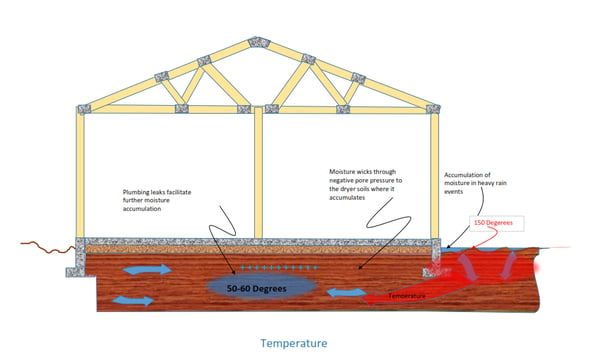
Temperature - With the inside of the house air conditioned, the soil under the slab in the center areas is much cooler than the soil on the outside of the house. Particularly as the sun beats down on it. The differential can be as much as 100 degrees. Claudia Zapata PhD, Professor of Geotechnical Engineering at Arizona State University, has conducted several studies documenting the effect of water accumulating to cooler soils.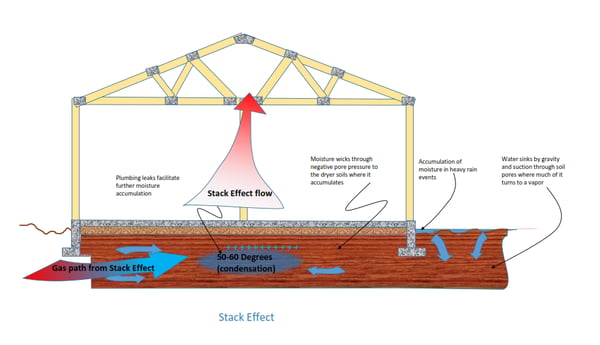 The Stack Effect - Radon Scientists have documented the stack effect for many years. As hot air rises to the attic, and exits the vents, it is replace with air and gasses from the lower portions of the structure. Particularly through the foundation from the soil under it and around it. The stack effect has been documented to pull Radon (a radioactive gas) into the structure from as far away as 20 feet from the house’s perimeter. Water vapor is a gas as well and follows the same path. Except as water reaches the cooler interior soils, it cools and condenses. As it does so the molecule grows significantly as is undergoes transformation from a gas to a liquid. Thus it is unable to follow other gases into the interior of the home, but is trapped under the slab where it accumulates.
The Stack Effect - Radon Scientists have documented the stack effect for many years. As hot air rises to the attic, and exits the vents, it is replace with air and gasses from the lower portions of the structure. Particularly through the foundation from the soil under it and around it. The stack effect has been documented to pull Radon (a radioactive gas) into the structure from as far away as 20 feet from the house’s perimeter. Water vapor is a gas as well and follows the same path. Except as water reaches the cooler interior soils, it cools and condenses. As it does so the molecule grows significantly as is undergoes transformation from a gas to a liquid. Thus it is unable to follow other gases into the interior of the home, but is trapped under the slab where it accumulates.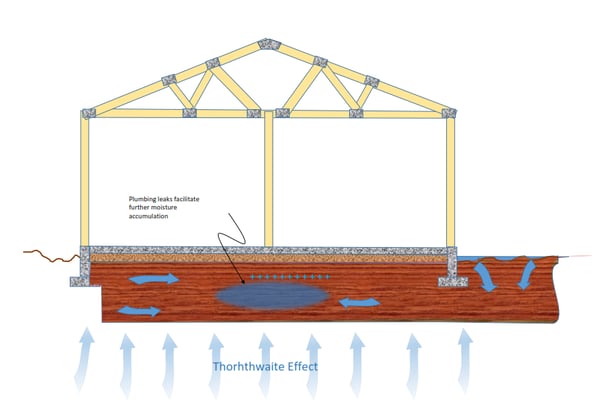
Thornthwaite Effect - This is a complicated Geotechnical concept of evapotranspiration that allows for the upper movement of water vapor from the water table, and other underground sources of water. This is easily demonstrated by burying plastic and noting the accumulation of water under the plastic. These 4 methods not only contradict the concept of the dissipation of water under the floor slab, but in fact show how water continues to accumulate over time. The only cost effective method of reversing the accumulation of moisture under as slab it to utilize the MoistureLevel system as outlined in an earlier post.
The MoistureLevel® Smart Foundation System dries out expansive clay soils beneath the foundation slab and corrects foundation heave.
We developed the MoistureLevel® Smart Foundation System to alleviate expansive soil problems beneath concrete slab foundations. This foundation repair technique borrows from reliable radon mitigation technology, using a vacuum and ventilation pipe to create air movement as well as suction on the under-slab soil. Introducing outside air to the damp, expansive soil causes evaporation to take place, making it possible to reduce soil moisture content and (as a result) damaging soil expansion.



